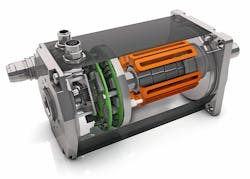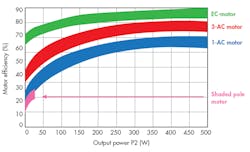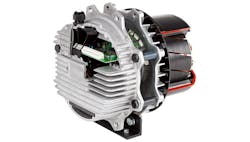What’s the Difference between AC, DC, and EC Motors?
Download this article in PDF format.
For motor applications, engineers have several options at their disposal. Typically, engineers can choose between direct-current (DC) or alternating-current (AC) motors. Machine Design has covered the difference between basic types of motors in the past.
The latest types of motors to enter the fray are those that help control the energy output and achieve higher energy efficiency. These electronically communicated (EC) motors are making strides in replacing dc and ac motors; especially with the need to achieve energy-efficiency regulations.
EC motors are DC brushless motors that are controlled by external electronic circuit board. This provides greater control and higher efficiency.
The Basics of DC and AC Motors
DC motors rely on carbon brushes and a commutation ring to switch the direction of the current and magnetic field polarity in a rotating armature. This interaction between the internal rotor and fixed permanent magnets induces the rotation of the motor.
According to maxon motors, DC motors are limited by their brush system and have a lifespan of 1000-1500 hours; less than 100 hours if under extreme loads. Some motors may operate to 15,000 hours under favorable operating conditions. The high speed of rotation is only limited by commutation, typically achieving up to approximately 10,000 rotations per minute.
DC motors have a high efficiency rate, but suffer from specific losses. They lose efficiency due to the initial resistance in the winding, brush friction, and eddy-current losses.
AC induction motors use a series of coils powered and controlled by AC input voltage. The stator field is created from the input voltage, and the rotor field is induced by the stator field. The other type of AC motor is a synchronous motor that is able to operate with precision supply frequency. The magnetic field is generated by a current delivered through slip rings or a permanent magnet. They run faster than induction motors due to the fact that the speed is reduced by the slip of the asynchronous motor.
The ac motors are meant to operate a specific point on a performance curve. This curve coincides with the peak efficiency of the motor. Outside of this point, the efficiency of the motor drops significantly. AC motors consume additional energy to create a magnetic field by inducing a current on the rotor. Consequently, AC motors are less efficient than DC motors. In fact, the DC motor is 30% more efficient than AC motors due to the secondary magnetic field being generated from the permanent magnets rather than copper windings.
The Efficiency of Electronically Commutated Motors
The chart compares the motor efficiency of an EC motor, three-phase induction AC motor, one-phase AC induction motor, and a shaded pole motor.
EC motors are brushless dc motors controlled by external electronics—either an electronic circuit board or variable-frequency drive. The rotor contains permanent magnets and the stator has a set of fixed windings. The mechanical commutation is performed by the electronic circuitry. The circuit board switches the phases in the fixed windings to keep the motor turning. This supplies the right amount of armature current. When the current is delivered in the right direction at the precise time, the higher the accuracy is achieved. Since the motor’s speed is controlled by external electronics, EC motors do not have a limited synchronous speed.
EC motors have several benefits. Because EC motors have no brushes, they do not spark or have a short life due to brushes. Other advantages include the fact that they do not waste power because the electronics control the stator; they provide better performance and controllability, and they run cooler than induction motors. In terms of size, small motors can achieve the same output as traditional DC or AC motors. Furthermore, the smaller motor saves space, and when the manufacturer uses an external rotor rather than a shaft motor, even more space savings are possible.
Power distribution is much cleaner with an EC motor. Brushless DC motors depend on a separate DC power supply. And an AC motor’s power supply usually adds extra cost and complexity. EC motors can connect directly to AC main power supply with their integrated electronics. They do not completely depend on voltage or frequency; hence, small changes in voltage do not affect motor output.
When comparing efficiency of an EC motor to an AC shaded pole motor or an AC permanent-split capacitor motor, shaded pole motors have an efficiency range of 15 to 25%, permanent-split capacitors (PSC) range from 30 to 50%, and EC motors have an efficiency of 60 to 75%. In a report from the Department of Energy in 2013, EC motors were found to be the most efficient upgrade option for current motor applications.
The report states “The range of efficiency for PSCs is very broad, for example 35-50% in airflow applications, especially when operating at less than full load. EC motors can have a more narrow range of efficiency over different speeds, typically around 70% for motors that have fractional horsepower and above 80% for those at integral horsepower.”
EC motors can be found in lower power output applications (e.g., small fans, servomotors, and motion-control systems). They are also finding their way into several small appliances with high power output needs, including conveyor belts and condenser units.
In terms of controlling speed, EC motors have multiple speed controls as a standard option. AC motors, for example, are available at multiple speeds with an optional external speed controller. The external controller adjusts the incoming voltage for AC motors, which alters their sine wave and in turn taxes the motor lifetime and increases noise.
For EC motors, the commutation circuits accept inputs with pulse-width modulation of 4 to 20 mA and 0 to 10 V. This controls the speed in a range of 10% to 100%. Monitoring of EC motors is simple with the integrated circuit, and can be easily accessed by the designer to provide feedback. Lastly, EC motors provide a soft start, reduced noise, and lower motor temperature.
EC motors are typically used for lower power output applications, like small fans, servomotors, and motion-control systems. However, with advances in electronics and materials, EC motors finding their way into larger output scenarios, up to 12 kW and higher. Several small appliances are game, too, including conveyor belts and condenser units.




